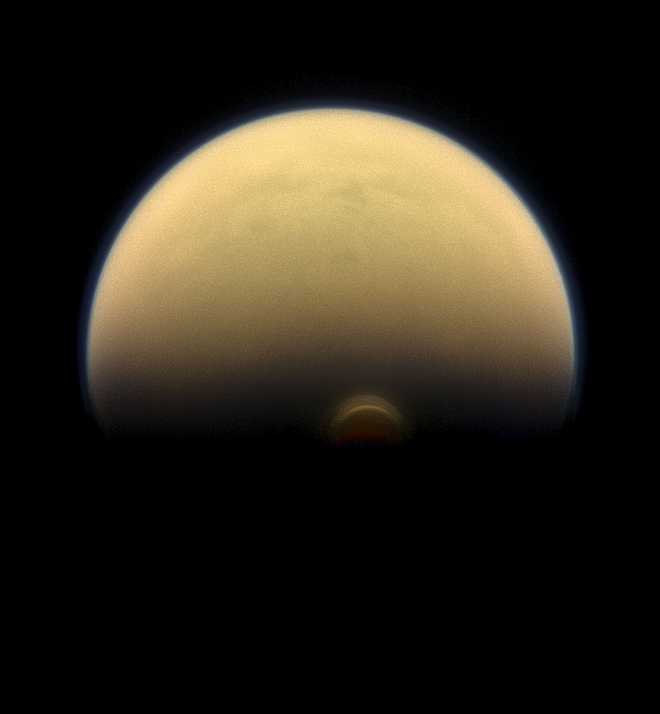
In this image released by NASA, the south polar vortex at Saturn’s moon Titan still stands out against the orange and blue haze layers that are characteristic of Titans atmosphere. Images like this, from NASA’s Cassini spacecraft, lead scientists to conclude that the polar vortex clouds form at a much higher altitude — where sunlight can still reach —than the lower-altitude surrounding haze. AFP photo
Washington
Scientists have said NASA's Cassinis mission has allowed them to observe the pattern of seasonal changes on Saturn's largest moon, Titan, in exquisite detail.
"Cassini's long mission and frequent visits to Titan have allowed us to observe the pattern of seasonal changes on Titan, in exquisite detail, for the first time," said Athena Coustenis, a member of Cassini's Composite Infrared Spectrometer team at the Observatoire de Paris.
Winter is taking a grip on Titan's southern hemisphere, and a strong, whirling atmospheric circulation pattern — a vortex — has developed in the upper atmosphere over the southpole, the probe has revealed.
Cassini has observed that this vortex is enriched in trace gases — gases that are otherwise quite rare in Titan's atmosphere. Cassini's observations show a reversal in the atmosphere above Titan's poles since the spacecraft arrived at Saturn in 2004, when similar features were seen in the northern hemisphere, the scientists said.
"We arrived at the northern mid-winter and have now had the opportunity to monitor Titan's atmospheric response through two full seasons," Coustenis noted.
Heat is circulated through Titan's atmosphere via a pole-to-pole cycle of warm gases upwelling at the summer pole and cold gases subsiding at the winter pole.
Cassini's observations have shown a large-scale reversal of this system, beginning immediately after the equinox in 2009.
Titan's hemispheres have responded in different ways to these seasonal changes.
The wintry effects have led to a temperature drop of 40 degrees Celsius in the southern polar stratosphere over the last four years.
This contrasts with a much more gradual warming in the northern hemisphere, where temperatures remained stable during the early spring, the scientists said.
The findings are being presented at the joint 48th meeting of the American Astronomical Society Division for Planetary Sciences and 11th European Planetary Science Congress (EPSC), this week in Pasadena, California. — IANS



























